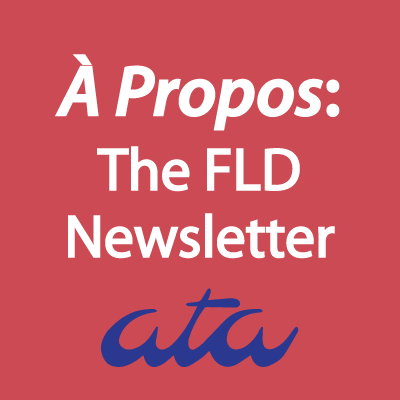 This is part of a continuing series of Proust questionnaires answered by members of the FLD Leadership Council. Beth Smith is a French to English translator specializing in tourism, advertising/marketing, and the psychology of happiness (an accidental specialization developed when translating the book The Finance of Happiness by Renaud Gaucher).
This is part of a continuing series of Proust questionnaires answered by members of the FLD Leadership Council. Beth Smith is a French to English translator specializing in tourism, advertising/marketing, and the psychology of happiness (an accidental specialization developed when translating the book The Finance of Happiness by Renaud Gaucher).
How did you get involved in translation?
I did my first translation back in grad school. One of the professors was editing a special edition of a journal and needed a bunch of people to translate texts, so he asked me to translate an excerpt from a Haitian novel. I enjoyed it, I got paid, but never really thought about translation again. Several years later (in 2007, I think), a French friend who is a filmmaker asked me if I would translate one of his scripts into English. I enjoyed it so much that I started researching translation, did the NYU certificate, and here I am.
Do you have a favorite French or English book?
I’m going to reveal my lowbrow tendencies here, but in English, I’d have to say the Harry Potter series. Ok, it’s not a single book, but I’m not going to pick one over the others. I’ve read the series several times and have spent much time over the years discussing the books and movies with friends, students, acquaintances, random people, errr… anyway. Harry Potter.
In French, I’m really torn, but I’m going to go with Boris Vian’s L’écume des jours. I read it for the first time in a grad school class, and struggled a bit, as I had only been studying French for four years at that point. But I love Vian’s inventiveness and the way he plays with language, plus there’s such heartbreak at the end. In a good way.
Where would you most like to live?
The obvious answer is “somewhere in France,” as that was something I dreamed of for a long time. But in the summer of 2014, I went to visit a friend in The Netherlands, and he took me to the island of Texel for a day. For some reason, I completely fell in love with it: the beach, the boats in the harbor, the small towns, the cute houses, everything. I’m not even a beach person! So I have a semi-plan to eventually move to Texel. At the moment, I’m still teaching full-time as well as translating, but eventually I’ll take the plunge into full-time freelancing. Then who knows?
What is your favorite quote?
What do you want? A medal or a chest to pin it on?
This is kind of obnoxious and I’m not sure it’s an actual quote, but my dad used to say it to me all the time when I was a kid, and it makes me laugh. I never got a medal, so I should have asked for the chest!
What do you consider your greatest achievement?
Buying a house. My finances were a shambles for several years after grad school.